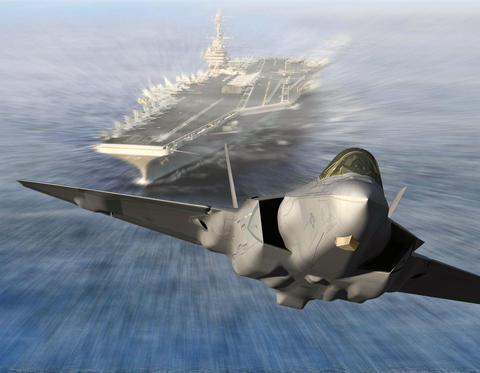F-35 Joint Strike Fighter Program Takes Another Hit

More bad news for the F-35 "Lightning" Joint Strike Fighter program - this time from the US Navy's Chief of Naval Operations Admiral Jonathan Greenert. In the July 2012 issue of the US Naval Institute's magazine Proceedings Admiral Greenert indirectly calls into question one of the key assumptions undergirding the development of the F-35C (the Navy's version of the JSF): the need for stealth.
As part of a larger article detailing why the Navy needs to focus on building dependable, affordable platforms capable of delivering a wide range of payloads to flexibly adapt to numerous missions Greenert takes a big swing at the need for weapons systems designed around stealth capabilities (i.e. the F-35C) over other performance metrics possessed by much more affordable weapons such as the Tomahawk missle or F/A-18E/F Super Hornets and Growlers.
You can see here in this extended quote what Greenert is getting at (with emphasis added):
"The rapid expansion of computing power also ushers in new sensors and methods that will make stealth and its advantages increasingly difficult to maintain above and below the water. First, though, military sensors will start to circumvent stealth of surface ships and aircraft through two main mechanisms:
• Operating at lower electromagnetic frequencies than stealth technologies are designed to negate, and
• Detecting the stealth platform from angles or aspects at which the platform has a higher signature.
U.S. forces can take advantage of those developments by employing long-range sensor, weapon, and unmanned-vehicle payloads instead of using only stealth platforms and shorter-range systems to reach targets.
Stealth ships and aircraft are designed to have a small radar or infrared electromagnetic signature at specific frequencies. The frequency ranges at which stealth is designed to be most effective are those most commonly used by active radar or passive infrared detection systems. At lower frequencies detections do not normally provide the resolution or precision necessary for accurate targeting. Using more powerful information-processing, however, military forces will be able to develop target-quality data from these lower-frequency passive infrared signals or active-radar returns.
The aspects at which stealth platforms are designed to have their smallest signature are those from which detection is most likely. For example, an aircraft or ship is designed to have a small signature or radar return when it is approaching a threat sensor—or has a “nose-on” aspect. Improved computer processing will produce new techniques that can detect stealth platforms at target aspects from which they have higher radar returns. Multiple active radars, for instance, can combine their returns through a battle-management computer so radar detections from a stealth platform’s less-stealthy side, underside, or rear aspect can be shared and correlated to allow the stealth platform to be detected and attacked. Similarly, passive radar receivers can capture the electromagnetic energy that comes from transmitters of opportunity—such as cell-phone or TV towers—and bounces off a stealth platform at a variety of angles. With better processing in the future, those weak, fragmented signals can be combined to create actionable target information.
Those developments do not herald the end of stealth, but they do show the limits of stealth design in getting platforms close enough to use short-range weapons. Maintaining stealth in the face of new and diverse counterdetection methods would require significantly higher fiscal investments in our next generation of platforms. It is time to consider shifting our focus from platforms that rely solely on stealth to also include concepts for operating farther from adversaries using standoff weapons and unmanned systems—or employing electronic-warfare payloads to confuse or jam threat sensors rather than trying to hide from them."
Now, if this isn't an open endorsement of purchasing unmanned aircraft, stand-off weapons, and electronic attack aircraft such as the F-18 Growler (which the Navy has shrewdly been continuing to purchase along with Super Hornets over F-35C's as the latter program stagnates) I don't know what is (remembering the obstacles that often prevent active duty officers from freely speaking their minds this seems to be about as clear of a shot at the F-35 as a high ranking officer can currently make without explicitly referencing the F-35). What do you think?



Post new comment